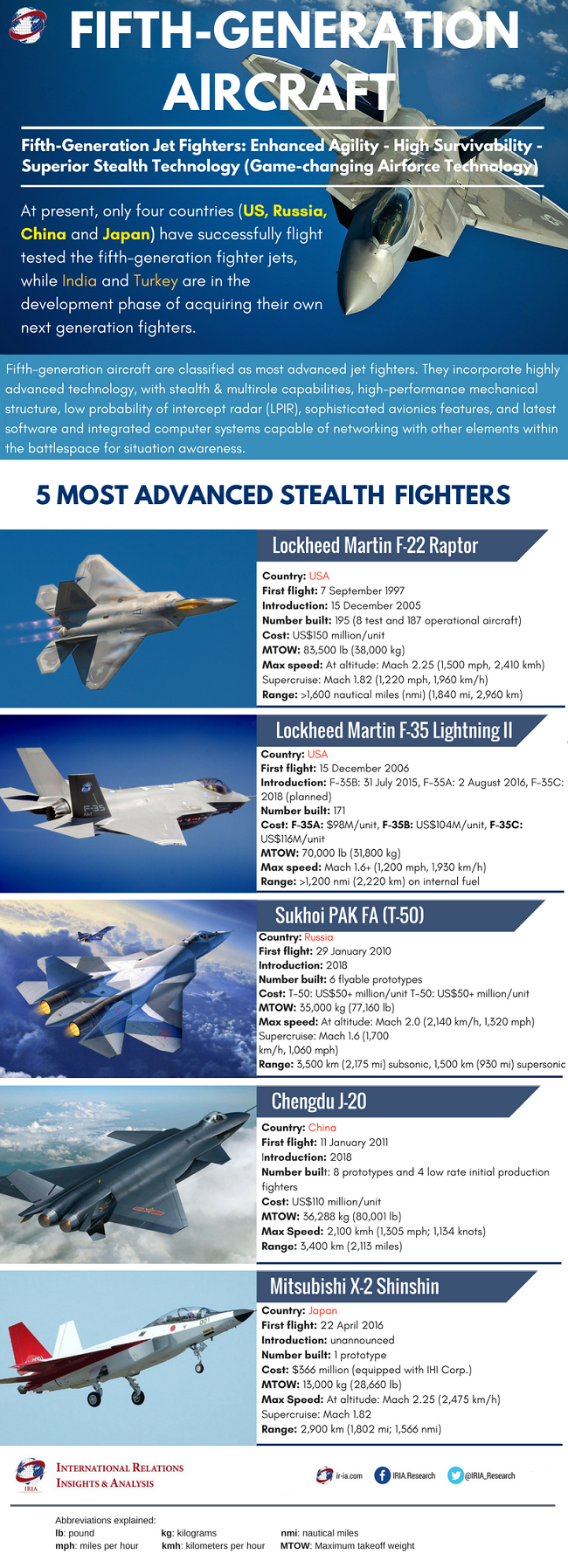Fifth-Generation Aircraft:
Enhanced Agility - High Survivability - Superior Stealth Technology
IRIA - Exclusive - Last updated on December 09, 2021
Fifth-generation aircraft are classified as most advanced jet fighters. They incorporate highly advanced technology, with stealth and multirole capabilities, high-performance mechanical structure, low probability of intercept radar (LPIR), sophisticated avionics features, and highly advanced software and integrated computer systems capable of networking with other elements within the battlespace for situation awareness.
At present, only four countries (US, Russia, China and Japan) have successfully flight tested the fifth-generation fighter jets, while India and Turkey are in the development phase of acquiring their own next generation fighters.
The five most advanced stealth jet fighters that have touched the sky include, American Lockheed Martin F-22 Raptor and Lockheed Martin F-35 (A/B/C variants) Lightning II, Russian Sukhoi PAK FA (T-50), Chinese Chengdu J-20, and Japanese Mitsubishi X-2 Shinshin.
1. Lockheed Martin F-22 Raptor - US
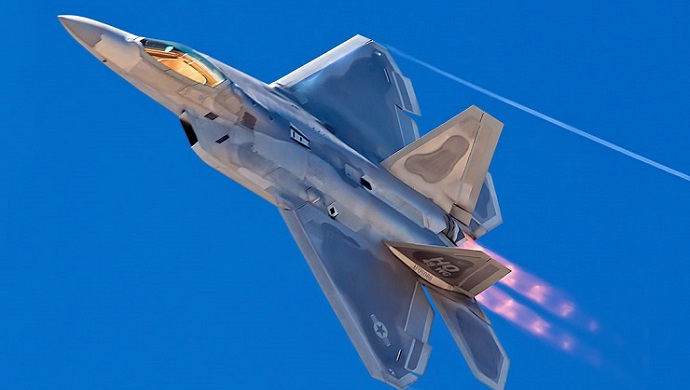
National origin: United States
Manufacturer: Lockheed Martin Aeronautics, Boeing Defense, Space & Security
First flight: September 7, 1997
Introduction: December 15, 2005
Number built: 195 (187 operational aircraft)
Cost: $150 million to $227 million/unit
Aircraft characteristics:
Length: 62 ft 1 in (18.92 m)
Wingspan: 44 ft 6 in (13.56 m)
Height: 16 ft 8 in (5.08 m)
Empty weight: 43,340 lb (19,700 kg)
Loaded weight: 64,840 lb (29,410 kg)
Maximum takeoff weight: 83,500 lb (38,000 kg)
Maximum speed:
At altitude: Mach 2.25 (1,500 mph, 2,410 km/h)
Supercruise: Mach 1.82 (1,220 mph, 1,960 km/h)
Range: >1,600 nautical miles (nmi) (1,840 mi, 2,960 km) with 2 external fuel tanks
Combat radius: 460 nmi (with 100 nmi in supercruise clean) (529 mi, 852 km)
Weapons:
Guns: 1× 20 mm (0.787 in) M61A2 Vulcan 6-barrel rotary cannon in right wing root, 480 rounds.
Air to air mission loadout:
6× AIM-120 AMRAAM
2× AIM-9 Sidewinder
Air to ground mission loadout:
2× 1,000 lb (450 kg) JDAM or 8× 250 lb (110 kg) GBU-39 Small Diameter Bombs
2× AIM-120 AMRAAM
2× AIM-9 Sidewinder
Hardpoints:
4× under-wing pylon stations can be fitted to carry 600 U.S. gallon drop tanks or weapons, each with a capacity of 5,000 lb (2,270 kg).
Avionics:
AN/APG-77 radar: 125–150 miles (200–240 km) against 1 m2 (11 sq ft) targets (estimated range)
AN/AAR-56 Missile Launch Detector (MLD)
AN/ALR-94 radar warning receiver (RWR): 250 nmi (463 km) or more detection range
MJU-39/40 flares for protection against IR missiles.
2. Lockheed Martin F-35 Lightning II - US
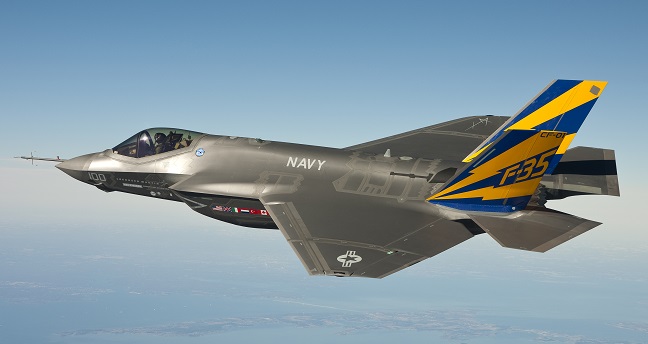
National origin: United States
Manufacturer: Lockheed Martin Corporation
First flight: December 15, 2006
Introduction: F-35B: July 2015 (United States Marine Corps), F-35A: August 2016 (United States Air Force), F-35C: February 2019 (United States Navy)
Number built: 730+ (as of December 2021)
Cost: F-35A: US$98M/unit (low rate initial production without engine, full production cost to be US$85M/unit), F-35B: US$104M/unit (low rate initial production without engine), F-35C: US$116M/unit (low rate initial production without engine)
Aircraft characteristics:
Length: 18.92m (62.1 ft)
Wingspan: 13.56m (44.5 ft)
Height: 5.08m (16.8 ft)
Empty weight: 43,340 lb (19,700 kg)
Loaded weight: 64,840 lb (29,410 kg)
Maximum takeoff weight: 83,500 lb (38,000 kg)
Maximum speed:
At altitude: Mach 2.25 (1,500 mph, 2,414 km/h)
At sea level: Mach 1.21 (921 mph; 1,482 km/h)
At supercruise: Mach 1.82 (1,220 mph, 1,963 km/h)
Range: 3,000 km (1,600 nmi) with 2 external fuel tanks
2,800 km (1,500 nmi) on internal fuel
Combat radius: 850km (460 nmi) clean with 185km (100 nmi) in supercruise
1,407 km (760 nmi) for internal air to air configuration
Weapons:
Guns: 1 × General Dynamics 25 mm (0.984 in) GAU-22/A 4-barrel rotary cannon, internally mounted with 180 rounds.
Hardpoints: 6 × external pylons on wings with a capacity of 15,000 lb (6,800 kg) and two internal bays with two pylons with a capacity of 3,000 (1,360 kg) for a total weapons payload of 18,000 lb (8,100 kg) and provisions to carry combinations of missiles and bombs.
Missiles:
Air-to-air missiles: AIM-120 AMRAAM, AIM-9X Sidewinder, IRIS-T, MBDA Meteor (pending further funding).
Air-to-surface missiles: AGM-88 AARGM, AGM-158 JASSM, Brimstone missile / MBDA SPEAR 2, SPEAR 3, Joint Air-to-Ground Missile (JAGM), SOM.
Anti-ship missiles: Joint Strike Missile (JSM), Long Range Anti-Ship Missile (LRASM).
Bombs:
Mark 84 or Mark 83 or Mark 82 GP bombs, Mk.20 Rockeye II cluster bomb, Wind Corrected Munitions Dispenser (WCMD) capable, Paveway series laser-guided bombs, Small Diameter Bomb (SDB), Joint Direct Attack Munition (JDAM) series, AGM-154 JSOW, B61 mod 12 nuclear bomb.
Avionics:
Northrop Grumman Electronic Systems AN/APG-81 AESA radar
AN/AAR-56 Missile Launch Detector (MLD)
AN/ALR-94 radar warning receiver (RWR)
Lockheed Martin AAQ-40 E/O Targeting System (EOTS)
Northrop Grumman Electronic Systems AN/AAQ-37 Distributed Aperture System (DAS) missile warning system
BAE Systems AN/ASQ-239 (Barracuda) electronic warfare system
MJU-39/40 flares for protection against IR missiles
Northrop Grumman AN/ASQ-242 CNI system.
3. Sukhoi Su-57 (T-50) - Russia
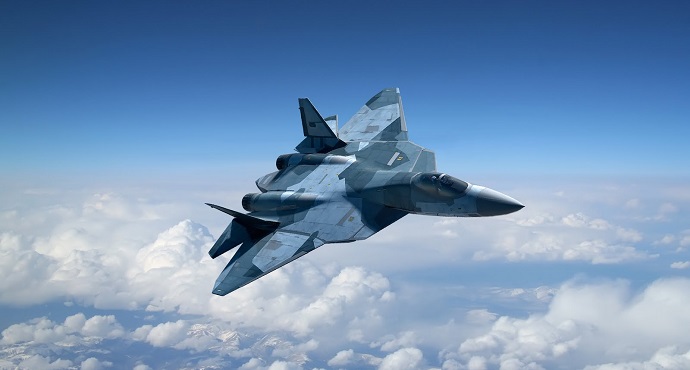
National origin: Russia
Manufacturer: Komsomolsk-on-Amur Aircraft Production Association (KnAAPO), Novosibirsk Aircraft Production Association (NAPO)
First flight: January 29, 2010
Introduction: December 25, 2020
Number built: 12 (10 test, and 2 serials)
Cost: $25 million to $100 million (depending on specs)
Aircraft characteristics:
Length: 20.1 m (65.11 ft)
Wingspan: 14 m (46.3 ft)
Height: 4.6 m (15.1 ft)
Empty weight: 18,000 kg (39,680 lb)
Loaded weight: 25,000 kg (55,115 lb) typical mission weight, 29,270 kg (64,530 lb) at full load
Maximum takeoff weight: 35,000 kg (77,160 lb)
Maximum speed:
At altitude: Mach 2.0 (2,140 km/h, 1,320 mph)
Supercruise: Mach 1.6 (1,700 km/h, 1,060 mph)
Range: 3,500 km (2,175 mi) subsonic, 1,500 km (930 mi) supersonic.
Weapons:
Guns: 1× 30 mm (1.181 in) 9A1-4071K (GSh-301) cannon in right LEVCON root.
Air to air loadout: 4x R-77M or 4x izdeliye 810, 2x K-74M2 or 2x izdeliye 300.
Air to ground loadout: 4x Kh-38M or 4x Kh-58UShK or 8x KAB-250 or 4× KAB-500, 2× K-74M2 or 2× izdeliye 300.
Air to sea loadout: 4x Kh-35, 2x K-74M2 or 2× izdeliye 300.
Hardpoints: Six external hardpoints and six internal hardpoints. Kh-31, R-73, R-77.
Avionics
Sh121 multifunctional integrated radio electronic system (MIRES)
N036 Byelka radar system
N036-1-01: Frontal X-band AESA radar
N036B-1-01: Cheek X-band AESA radars for increased angular coverage
N036L-1-01: Slat L-band arrays for IFF
L402 Himalayas Electronic countermeasure suite
101KS Atoll electro-optical system
101KS-O: Laser Directional Infrared Counter Measures
101KS-V: Infra-red search and track
101KS-U: Ultraviolet Missile Approach Warning system
101KS-P: thermal imager for low altitude flying and night landing
101KS-N: Targeting pod.
4. Chengdu J-20 - China
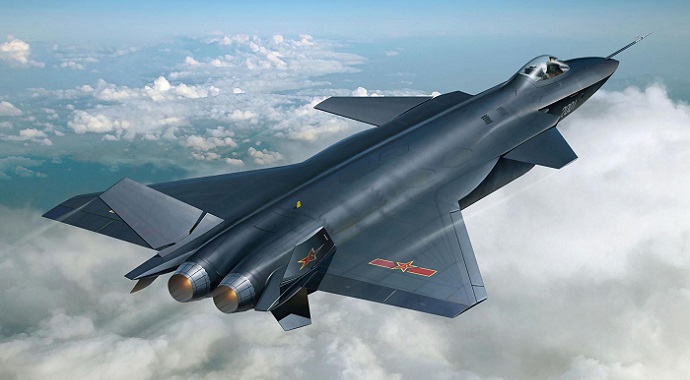
National origin: China
Manufacturer: Chengdu Aerospace Corporation
First flight: 11 January 2011
Introduction: 2017
Primary user: People's Liberation Army Air Force
Variants: J-20A (single-seat variant, incorporated in March 2017),
J-20S (twin-seat variant, spotted in October 2021)
Number built: 150 units (estimated as of 2021)
Cost: ranging from $30 million to $120 million/unit
Aircraft characteristics:
Length: 21.2 m (69.7 ft)
Wingspan: 13 m (44.2 ft)
Height: 4.69 m (15.5 ft)
Empty weight: 19,391 kg (42,750 lb)
Loaded weight: 32,092 kg (70,750 lb)
Maximum takeoff weight: 36,288 kg (80,001 lb) upper estimate.
Maximum Speed: Mach 2.0 - 2,100 kmh (1,305 mph; 1,134 knots)
Range: 5,500 km (3,400 miles) with 2 external fuel tanks
Weapons:
PL-10 SRAAM
PL-12 Medium Range AAM
PL-15 BVR long range AAM
PL-21 Long Range AAM
LS-6/50 kg and LS-6/100 kg Small-diameter precision-guided bomb
Anti-radiation missile.
Hardpoints: 8
Use of various Russian/Chinese air-to-air missiles, air-to-surface missiles, anti-radiation missiles, laser-guided bombs and conventional drop bombs are assumed. A standard internal cannon for close-in combat is probable. 4x under-wing pylon capable of carrying drop tanks.
Avionics:
Type 1475 (KLJ-5) Active Electronically Scanned Array Radar
EORD-31 Infrared search and track
EOTS-86 electro-optical targeting system
Distributed aperture system
5. Mitsubishi X-2 Shinshin - Japan
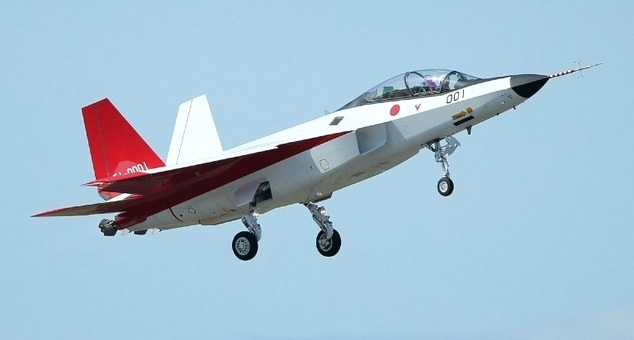
National origin: Japan
Manufacturer: Mitsubishi Heavy Industries
First flight: April 22, 2016
Primary user: Japan Air Self-Defense Force
Number built: 1 prototype
Cost: US$366 million (equipped with IHI Corp.)
Aircraft characteristics
Length: 14.174 m (46.6 ft)
Wingspan: 9.099 m (29.1 ft)
Height: 4.514 m (14.1 ft)
Empty weight: 9,700 kg (21,385 lb)
Maximum takeoff weight: 13,000 kg (28,660 lb)
Maximum speed: Mach 2.25, 2,475 km/h (Mach 1.82 supercruise)
Range: 2,900 km (1,802 mi; 1,566 nmi)
Combat range: 761 km (473 mi; 411 nmi)
Weapons:
Presumed internal 20mm cannon. Proposed six internal weapons bays for delivering air-to-air and air-to-surface guided/homing munitions.
Hardpoints: 0
Related Reports and Articles
Regions
Issues































